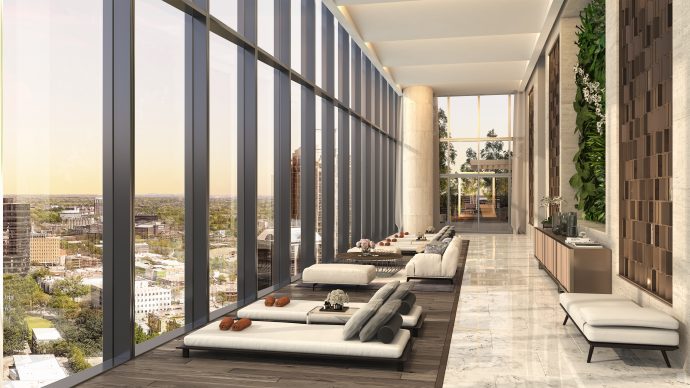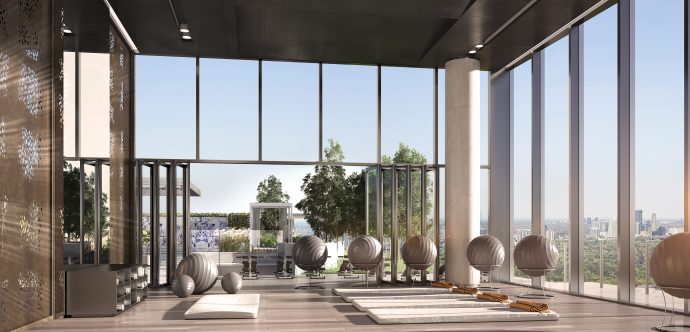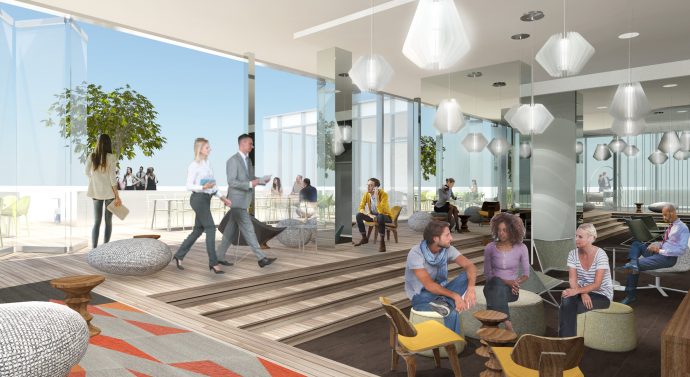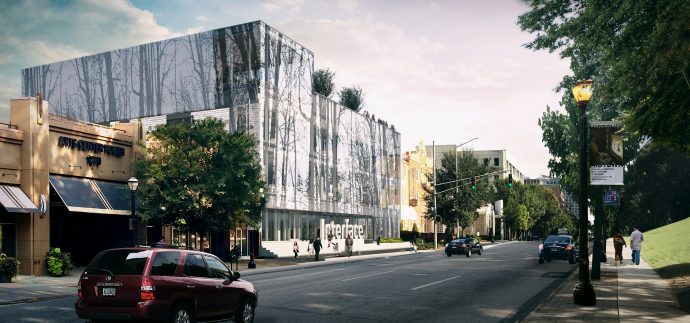It’s easy to follow fads when it comes to workspace design. Perkins + Will’s Paula McEvoy explores how an evidence-based approach to design using peer-reviewed research findings will result in built environments with substantial impacts on the occupants’ well-being.

The Pullman Car Company, manufacturer of railroad cars, introduced one of the earliest examples of workplace fitness programs when, in 1879, it launched its own athletic association. In 1894, the President of NCR Corporation instituted morning and afternoon exercise breaks and ten years later built an employee gym. At the time, few of Pullman and NCR’s fellow corporate behemoths followed suit. Now, corporations not only embrace health and fitness programs, but have augmented these initiatives well beyond the realm of exercise. Today’s forward-thinking companies strive to affect their employees’ entire well-being through workplace design strategies that impact a range of dimensions including physical, mental, financial, and social.
Alongside the great enthusiasm for workplaces designed to support employee well-being is a degree of uncertainty about which tactics are fleeting fads and which are fact-based and enduring. In a dynamic market, it is easy to fall into bandwagon design decisions that follow fads. Alternatively, an evidence-based approach bases workspace design on peer-reviewed findings from research and practice. The result is a built environment more certain to have a substantial and enduring impact on the well-being of its occupants. Design certifications like Fitwel (health) and RELi (resilience) have grown from these evidence-based efforts. In turn, these facts and standards are informing the development of healthier and more productive work environments in organizations ranging from carpet tile manufacturer, Interface, to the Centers for Disease Control and Prevention.
The Research Labs and the AREA Research non-profit group are two programs at Perkins+Will, a global architecture and design firm, that partner with academia, industry experts and leading design associations to improve the built environment, and by extension, the lives of its inhabitants. Often, Perkins+Will offices are used as living labs to test products and approaches that claim to promote well-being. It is through the application of these evidence-based initiatives that we’re able to make independent design recommendations that go beyond the latest trends. From these efforts, fresh facts have emerged on what works and what doesn’t when it comes to designing corporate offices for well-being.

This hands-on approach to well-being is essential for breaking through the clutter of questionable reporting. Sometimes, such research can discern when critics’ scoffing opinions of a trend may be ill-informed. The standing desk phenomenon provides an instructive example. The global standing desk market is on pace to experience double digit percentage growth over the coming years, hitting $2.8 billion by 2025 according to a 2017 study by Acute Market Reports. Whether or not those growth rates prove accurate, it is clear that companies have already invested significant capital in this trend without necessarily knowing the efficacy of standing desks. Is it money well spent? A 2016 Huffington Post article blasted this headline, “Experts Say Your Standing Desk Is Basically Useless” while “Is Your Standing Desk Doing More Harm Than Good?” read the headline of a December 2017 article in U.S. News And World Report. With an abundance of both positive and negative hype about standing desks available, how does a designer decide what to recommend?
Seeking a more thorough investigation, the American Society of Interior Designers Foundation funded a multidisciplinary team led by the Center for Active Design, in collaboration with Icahn School of Medicine at Mount Sinai Hospital, Perkins+Will, and Steelcase. The 2017 study here evaluated the health and wellness impacts of standing desks in the workplace and concluded that adjustable workstations are indeed linked to increased worker productivity, improved mental concentration, and improved overall health. “This study found adjustable workstations beneficial in reducing sedentary behavior both in and outside of the workplace. In addition, these behavioral changes were sustained over time and were associated with more energy, less muscle pain, and more awareness of standing posture. When considering total worker health, employers would be smart to include options for adjustable workstations,” said Dr. Elizabeth Garland, associate professor of Environmental Medicine and Public Health at the Icahn School of Medicine at Mount Sinai.
There are, of course, so many decisions that go into any workplace well-being design that no one entity can conduct primary research on all factors. In those cases, a deep and systematic review and organization of resources, news and data can be the next best thing. The Material Transparency website and Precautionary List of Hazardous Building Materials are prime examples of this approach. The Transparency website is a gathering point for evidence supporting the open and honest disclosure of ingredient lists for each catalogued product and encourages designers to make product selections based upon government-backed scientific research. The site also features a Precautionary List of Hazardous Building Materials, which serves as a screening filter to identify building materials that contain chemicals of concern in an effort to help design teams find alternatives that use the fewest possible toxic substances. The Precautionary List also aims to influence manufacturers to re-engineer products for reduced toxicity.
Well-being has come to life in part because of fruitful partnerships with thought leaders and forward-thinking clients. For instance, Fitwel, an evidence-based design certification standard developed by the U.S. Centers for Disease Control and Prevention (CDC) with the U.S. General Services Administration (GSA), measures how workplace design and policies impact occupant health and well-being. Fitwel – a digital scorecard and certification system that is the health and well-being analog to the environmentally-focused LEED certification – is the outcome of substantial research, including 89 pilot projects over a five-year development period. A natural fit with active design principles, The Center for Active Design was selected to bring Fitwel to market.
Fitwel certification uses a weighted scoring system to assess design and operational strategies that address occupant health. It evaluates a space’s performance in seven health impact categories: healthy food options, occupant safety, physical activity, social equality, well-being, reduction of morbidity and absenteeism, and community health. The Fitwel Scorecard includes over 55 evidence-based design and policy strategies, with each strategy assigned unique point values based on the associated strength of evidence. Those with stronger, multi-faceted impacts receive more points. For example, the strategy “Locate an accessible stairwell equally or more visible than any elevators and/or escalators at the main entrance” has 4.33 total possible because it has three associated impact categories, while the strategy of providing “a dedicated lactation room equipped with a lactation station, refrigerator and sink” has 5.66 total possible points because of the documented impact that the availability of these rooms has on the health of both mother and child.
Another research-driven program related to workplace well-being and the built environment is RELi, a resilient building and design standard developed by Perkins+Will in conjunction with the Institute for Market Transformation to Sustainability and adopted by the U.S. Green Building Council. RELi prescribes methods for designing more resilient buildings and communities that can better withstand environmental, social, and economic shocks and stressors. As companies strive to take a balanced, whole systems view of their employees’ health and well-being , RELi responds to this goal by considering the cascading consequences of unforeseen shocks and stressors, like hurricanes, super storms, heat waves, and even social volatility.

Of course, evidence-based design approaches for well-being in the workplace meet their ultimate performance test in actual deployment. For the evidence-based designer, the bar is perceptibly higher when the client is itself a pioneer of the corporate sustainability movement, Interface Inc. Always a design leader, in 1994 Interface founder Ray Anderson set the stage for socially responsible design when he committed the company to becoming “the world’s first environmentally sustainable company,” with a mission to eliminate any negative impact the company has on the environment by 2020.
In the 20+ years since Anderson’s sustainability pledge, Interface’s commitment has only grown stronger. In 2014, for instance, Interface launched its Human Spaces website as a resource and community for those interested in the growing study of biophilic, human-centered design – focusing on the relationships between nature, human biology and how the built environment can affect well-being.

In 2016, when Interface decided to relocate its corporate headquarters to midtown Atlanta and to repurpose existing commercial space rather than build new, it naturally sought to create a space that would be a showcase for its sustainability practices and employee-centric culture; a space that positively contributes to the well-being of its employees as well as the surrounding community. Interface is partnering with Perkins+Will for architecture and interior design on the newly repurposed building. One indication of Interface’s expectation that its new headquarters supports workforce well-being is its stated objective of earning the highest levels of certification from LEED and WELL (another evidence-backed standard for measuring, certifying, and monitoring features of the built environment that impact human health and well-being). In an effort to achieve high levels of employee-well-being, Interface’s new headquarters will employ the following sustainable practices:
- Healthy material choices
- Light controls for energy reduction
- Green roof
- Air filtration
- Water filtration
- Rainwater collection/reuse
- Efficient fixtures and faucets
- Wellness room
- Showers and lockers
- Mother’s Room
- Visible stairs
- Collaborative Hub
- Focus Rooms
- Noise reduction
- Outdoor terrace
- Privacy spaces for groups and individuals
Recently, the workplace well-being movement has moved beyond office walls. Just around the corner from Interface’s midtown Atlanta headquarters is a 53-floor high rise residential tower, No2 Opus Place, which is the first in the Southeast to attempt LEED, WELL and Fitwel certification. Opus Place will include an extensive fitness facility, a yoga room, wellness lounge, spa treatment rooms, and employs a Wellness Director to manage related services.
Design should improve health and well-being by redefining the relationship between the built environment, people, and the natural environment. This once insurmountable goal has become possible through testing and refining evidence-based design strategies that successfully measure wellness, productivity and satisfaction in finite metrics. With a wealth of data, proven certification standards, and wellness-savvy design professionals, creating office spaces that promote employee well-being is no longer guesswork but instead a thoughtful, intentional fact-based endeavor.


